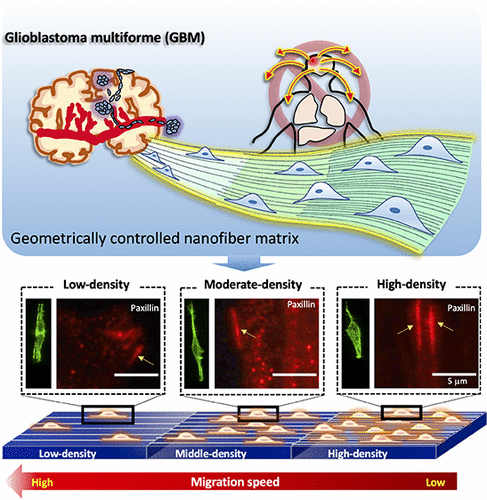Researchers have used high-density nanofibers that mimic the brain's microenvironment to trap cancer cells in research that paves the way for the development of innovative therapeutic solutions for aggressive brain cancers

[Translation by Dr. Moshe Nachmani]
Brain tumors are difficult to contain and are usually resistant to standard treatment methods. Predicting the behavior of cancer cells requires a better understanding of their proliferation mechanism. Now, researchers at Fukui University in Japan have used high-density nanofibers that mimic the brain's microenvironment to trap cancer cells in research that paves the way for the development of innovative therapeutic solutions for aggressive brain cancers.
Our body heals its injuries by replacing damaged cells with new, healthy cells. The new cells often migrate to the site of injury, in a process known as 'cell migration'. However, abnormal cell migration can also encourage the transfer and spread of cancer cells within the body. Glioblastoma multiforme (GBM) is one such example of a very violent brain tumor that spreads through the migration of cancer cells. The frequency with which such cancer cells spread and grow makes the usual methods of removing this cancer ineffective.
In addition, other treatment options such as radiotherapy and chemotherapy damage healthy cells and cause negative side effects. In order to develop improved healing methods, we need an accurate understanding of the invasion mechanism of this type of cancer cells. A possible alternative treatment method involves trapping the migrating cancer cells. It turns out that cell migration is dictated by the structure and directionality of the extracellular matrix (ECM) - fibrous structures around the cells. By inducing similar structures with the required directionality, it is possible, therefore, to control the migration process. Now, in a study published in an article in the scientific journalApplied Biomaterials, researchers from Fukui University in Japan developed a platform based on nanofibers that mimic the extracellular matrix in order to examine their effect on cancer cells. "We synthesized a surface of nanofibers where the density of the fiber changes from end to end using the method of 'electrospinning' and we tested brain cancer cells with it," said the lead researcher.
The researchers discovered clear differences in cell movement in nanofibers with different densities. They found that the denser fibers encouraged the formation of clusters of 'focal adhesions' in the cells that cause slower cell migration. Based on this negative correlation between the rate of cell movement and fiber density, the researchers were able to control and direct cell migration by designing a nanofiber surface with stepwise varying densities. By arranging the surfaces in a configuration of high to low density, they were able to limit the movement of the cells since most of them were simply trapped within the dense areas. On the other hand, the surfaces in a configuration of low to high density had the opposite effect and actually encouraged the migration. In addition, they noticed that the gaps between the areas that inhibit cell migration cause them to become trapped within the dense areas. Such unidirectional migration has been observed for the first time ever and the researchers have dubbed it a 'cell trap' in analogy to fish and insect traps that cause their prey to move in one direction before being captured.
"The study demonstrates the feasibility of trapping migrating cells with the help of electronically spun nanofibers, fibers that mimic the microenvironment of the brain," said the lead researcher. In light of these noteworthy findings, the team of researchers is excited about the future potential of its nanofibers. "Our system is available for the design of scaffolding materials, which are the basis of regenerative medicine, in combination with different processing methods of fibers and methods of surface treatment of materials. Such a combination could lead to the development of practical applications in the field of regenerative medicine," said the chief researcher. "In addition, the method can be used as a processing method for culture carriers for the efficient production of biological drugs, including proteins, antibodies and vaccines."
More of the topic in Hayadan:
